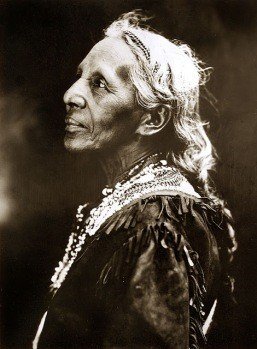
Emma Jane Mitchell Safford (1846-1932)
Emma Jane Mitchell Safford (1846-1932), the maker of a woven covered basket currently on loan to CAM from the Peabody Essex Museum, was well known in this region during her lifetime and was honored during the summer of 1923 as part of the 300th anniversary of the first English settlement in Gloucester.
A resident of nearby Ipswich, Safford was a member of the Wampanoag tribe. Her family came to Ipswich from Middleboro, on Massachusetts’ south shore, in the 1850s; Emma married Jacob Cheever Safford whose ancestors had been enslaved. Tradition holds that initially Emma Safford tried to blend into Ipswich’s white community, however, in time she embraced her Wampanoag heritage. Calling on Wampanoag traditions, she made baskets like the one on display at CAM (and also in the collection of the Smithsonian’s National Museum of the American Indian) to help support her family.
During the summer of 1923, Emma Safford and numerous other Indigenous people were invited to participate in festivities related to Gloucester’s 300th Anniversary. An extravagant parade was organized and with input from anthropologist Frank G. Speck (1881-1950), who summered on Cape Ann, great efforts were made to call out Indigenous peoples’ long and important history in this area. Safford rode in an open car in the parade, accompanied by Winnie Tantaquidgeon from the Mohegan tribe. Winnie’s sister, Gladys (who was also in the parade) had already begun studying anthropology with Frank Speck at the University of Pennsylvania. Gladys would go on to become a well-known medicine woman and advocate for Indigenous peoples.
A few weeks before the 300th parade took place, a lengthy article by Frank Speak appeared in the Gloucester newspaper. In it, Speck called out Emma Safford and the long history of her people in the region, noting that Safford’s family tree was “rooted in an antiquity which puts to the blush the boast of the most ancient white families of the land.” Safford’s covered basket currently on view at CAM was gifted to the Peabody Essex Museum in 1943 by Frank Speck.
To learn more about Frank Speck, watch Fictive Kin: Re-visiting the Relations of Frank Speck and His Indigenous Interlocutors with Dr. Marge Bruchac.